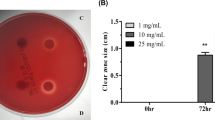Abstract
Chemical therapeutics targeted against H. pylori may lead to host toxicity and pathogen eradication failures. In this study, ethanolic extracts from five Lespedeza sp. plants were shown to inhibit the gastric-pathogen H. pylori and to modulate cytokine production. Disc agar diffusion assays showed that Lespedeza sp. ethanol extracts possess potent anti-H. pylori activity. Among the five plant extracts, the extracts from L. cyrtobotrya demonstrated the highest anti-H. pylori effect. The growth inhibitory effect against H. pylori was initiated after six h of treatment with plant extracts and the effect remained for a continuous period of 48 h. Incubation of the gastric cells infected with H. pylori with 1.25 to 50 mg/mL of sp. plant extracts resulted in a reduction of the production of cytokine IL-8. The plant ethanol extracts generally had little influence on AGS cell viability, indicating their safety for the treatment of bacterial infections. Three active fractions of L. cyrtobotrya also demonstrated similar anti-H. pylori and immuno-modulatory effects. Taken together, these results provide evidence that Lespedeza sp. plant extracts might be potential sources of new host friendly anti-H. pylori agents.
Similar content being viewed by others
References
Parsonnet, J., G. D. Friedman, and D. P. Vandersteen (1991) Helicobacter pylori infection and the risk of gastric carcinoma. N. Engl. J. Med. 325: 1127–1131.
Dunn, B. E., H. Cohen, and M. J. Blaser (1997) Helicobacter pylori. Clin. Micro. Rev. 10: 720–741.
Hentschel, E., G. Brandstatter, B. Dragsics, A. M. Hirschil, H. Nemec, K. Schutze, M. Taufer, and H. Wurzer (1993) Effect of ranitidine and amoxicillin plus metronidazole on the eradication of Helicobacter pylori and the recurrence of duodenal ulcer. N. Engl. J. Med. 328: 308–312.
Matsumoto, S., Y. Washizuka, Y. Matsumoto, S. Tawara, F. Ikeda, Y. Yokota, and M. Karita (1997) Appearance of a metronidazole-resistant Helicobacter pylori strain in an infected-ICR-mouesimodel and difference in eradication of metronidazole-resistant and -sensitive strains. Antimic. Agent. Chemother. 41: 2602–2605.
Kido, S., Y. Kitadai, N. Hattori, K. Haruma, T. Kido, M. Ohta, S. Tanaka, M. Yoshihara, K. Sumii, Y. Ohmoto, and K. Chayama (2001) Interleukin-8 and vascular endothelial growth factor-prognostic factors in human gastric carcinomas. Eur. J. Canc. 37: 1482–1487.
Ben-Baruch, A., D. F. Michiel, and J. J. Oppenheim (1995) Signals and receptors involved in recruitment of inflammatory cells. J. Biol. Chem. 270: 11703–11706.
Ndip, R. N., A. E. M. Tarkang, S. M. Mbullah, H. N. Luma, A. Malongue, L. M. Ndip, K. Nyongbela, C. Wirmum, and S. M. N. Efange (2007) In vitro anti-Helicobacter pylori activity of extracts of selected medicinal plants from North West Cameroon. J. Ethnoph. 114: 452–457.
Shih, Y. T., D. C. Wu, C. M. Liu, Y. C. Yang, I. J. Chen, and Y. C. Lo (2007) San-Huang-Xie-Xin-Tang inhibits Helicobacter pylori-induced inflammation in human gastric epithelial AGS cells. J. Ethnoph. 112: 537–544.
Park, C. W. (2007) The Genera of Vascular Plants of Korea. Academy Publishing Co., Seoul, pp. 617.
Baker, C. N., S. A. Stocker, D. H. Culver, and C. Thornsberry (1991) Comparison of the E test to agar dilution, broth microdilution, and agar diffusion susceptibility testing techniques using a special challenge set of bacteria. J. Clin. Microbiol. 29:533–538.
Alley, M. C., D. A. Scudiero, A. Monks, M. L. Hursey, M. J. Czerwinski, D. L. Fine, B. J. Abbot, J. G. Mayo, R. H. Shoemaker, and M. R. Boyd (1988) Feasibility of drug screening with panels of human tumour cell lines using a microculture tetrazolium assay. Cancer Res. 48: 589–601.
SAS Institute Inc., 2001. ADO/OLE Cookbook for the SAS Data Providers, Cary, NC: SAS Institute, Inc.
Yeo, H. D. (2009) The antibacterial activity and chemical analysis of medicinal plant extracts against Helicobacter pylori. Thesis of Master of Gyeongsang National Univ.
Burger, O., I. Ofek, M. Tabak, E. Weiss, N. Sharon, and I. Neeman (2000) A high molecular mass constituent of cranberry juice inhibits Helicobacter pylori adhesion to human gastric mucus. FEMS Imm. Med. Micro. 29: 295–301.
Mabe, K., M. Yamada, I. Oguni, and T. Takahashi (1999) In vitro and in vivo activities of tea catechins against Helicobacter pylori. Antimic. Agent. Chemother. 43: 1788–1791.
O’Gara, E. A., D. J. Hill, and D. J. Maslin (2000) Activities of garlic oil, garlic powder, and their diallyl constituents against Helicobacter pylori. Appl. Environ. Microbiol. 66: 2269–2273.
O’Mahony, R., H. Al-Khtheeri, D. Weerasekera, N. Fernando, D. Vaira, J. Holton, and C. Basset (2005) Bactericidal and anti-adhesive properties of culinary and medicinal plants against Helicobacter pylori. World J Gastroenterol 11: 7499–507.
Brown, J. C., G. Huang, V. Haley-Zitlin, and X. Jiang (2009) Antibacterial effects of Grape extracts on Helicobacter pylori. Appl. Env. Micro. 848-852.
Lee, C. and A. Jaworski (1987) Fractionation and HPLC determination of grape wine. J. Agric. Food Chem. 35: 257–259.
Vattem, D. A., Y. T. Lin, R. Ghaedian, and K. Shetty (2005) Cranberry synergies for dietary management of Helicobacter pylori infections. Proc. Biochem. 40: 1583–1592.
Lai, C. H., S. H. Fang, and Y. K. Rao (2008) Inhibition of Helicobacter pylori-induced inflammation in human gastric epithelial AGS cells by Phyllanthus urinaria extracts. J. Ethnopharmacol. 118: 522–526.
Lee, I. O., K. H. Lee, J. H. Pyo, J. H. Kim, Y. J. Choi, and Y. C. Lee (2007) Anti-inflammatory effect of capsaicin in Helicobacter pylori infected gastric epithelial cells. Helicobacter 12: 510–517.
Author information
Authors and Affiliations
Corresponding author
Rights and permissions
About this article
Cite this article
Yang, JK., Yeo, HD., Baik, SC. et al. Antibacterial and immuno-modulatory activity of ethanol extracts from Lespedeza sp. during Helicobacter pylori infections. Biotechnol Bioproc E 15, 1077–1083 (2010). https://doi.org/10.1007/s12257-009-3115-z
Received:
Revised:
Accepted:
Published:
Issue Date:
DOI: https://doi.org/10.1007/s12257-009-3115-z




